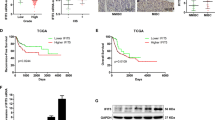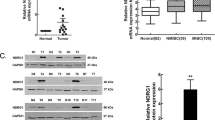Abstract
We investigate the role of the Lin28/let-7a/c-Myc pathway in non-muscle invasive bladder cancer (NMIBC). Using RT-PCR, western blot and immunohistochemistry techniques, the levels of pre-let-7a, let-7a, Lin28 and c-Myc RNA and/or proteins were determined in samples of normal bladder tissue and bladder cancer. Expression of pre-let-7a was found to be negatively correlated with the pathological grade of bladder cancer, while let-7a showed a positive correlation with bladder cancer pathological grade. Expression of Lin28 RNA and protein was not significantly different between normal bladder tissue and low-grade transitional cell carcinoma of bladder (TCC) but the expression levels in high-grade TCC were remarkably increased. Expression of c-Myc RNA and protein was significantly higher in bladder cancer samples in comparison to normal bladder tissue without correlation with cancer differentiation. Expression of all the above RNAs and proteins showed no significant difference in Ta and T1 stages. The Lin28/let-7a/c-Myc pathway plays an important role in NMIBC. In particular, expression levels of let-7a correlate with the degree of cancer differentiation but not cancer stage.





Similar content being viewed by others

References
Adhikary S, Eilers M (2005) Transcriptional regulation and transformation by Myc proteins. Nat Rev Mol Cell Biol 6:635–645
Bartel DP (2004) MicroRNAs: genomics, biogenesis, mechanism, and function. Cell 116:281–297
Cao D, Liu A, Wang F, Allan RW, Mei K, Peng Y, Du J, Guo S, Abel TW, Lane Z, Ma J, Rodriguez M, Akhi S, Dehiya N, Li J (2011) RNA-binding protei-n LIN28 is a marker for primary extragonadal germ cell tumors: an immunohis-tochemical study of 131 cases. Mod Pathol 24:288–296
Casadio V, Calistri D, Tebaldi M, Bravaccini S, Gunelli R, Martorana G, Bertaccini A, Serra L, Scarpi E, Amadori D, Silvestrini R, Zoli W (2012) Urine Cell-Free DNA integrity as a marker for early bladder cancer diagnosis: Preliminary data. Urol Oncol pii:S1078-1439(12)00255-4
Chang TC, Yu D, Lee YS, Wentzel EA, Arking DE, West KM, Dang CV, Thomas-Tikhonenko A, Mendell JT (2008) Widespread microRNA repression by Myc contributes to tumorigenesis. Nat Genet 40:43–50
Chang TC, Zeitels LR, Hwang HW, Chivukula RR, Wentzel EA, Dews M, Jung J, Gao P, Dang CV, Beer MA, Thomas-Tikhonenko A, Mendell JT (2009) Lin-28B transactivation is necessary for Myc-mediated let-7 repression and proliferation. Proc Natl Acad Sci USA 106:3384–3389
Cole MD, Henriksson M (2006) 25 years of the c-Myc oncogene. Semin Cancer Biol 16:241
Dangi-Garimella S, Yun J, Eves EM, Newman M, Erkeland SJ, Hammond SM, Minn AJ, Rosner MR (2009) Raf kinase inhibitory protein suppresses a metastasis signalling cascade involving LIN28 and let-7. EMBO J 28:347–358
Guo X, Zhang YM, Sun L, Zhou L, Wang Y, Qi ZY, Qin J, Li XX, Chen J, Gui YT, Cai ZM (2011) Expression and significance of LIN28 in bladder cancer and bladder cancer cell line. J Clin Uro 26:589–593
Han Y, Chen J, Zhao X, Liang C, Wang Y, Sun L, Jiang Z, Zhang Z, Yang R, Chen J, Li Z, Tang A, Li X, Ye J, Guan Z, Gui Y, Cai Z (2011) MicroRNA expression signatures of bladder cancer revealed by deep sequencing. PLoS ONE 6:e18286
He XY, Chen JX, Zhang Z, Li CL, Peng QL, Peng HM (2010) The let-7a microRNA protects from growth of lung carcinoma by suppression of k-Ras and c-Myc in nude mice. J Cancer Res Clin Oncol 136:1023–1028
Heo I, Joo C, Cho J, Ha M, Han J, Kim VN (2008) Lin28 mediates the terminal u-ridylation of let-7 prec-ursor MicroRNA. Mol Cell 32:276–284
Kang J, Shakya A, Tantin D (2009) Stem cells, stress, metabolism and cancer: a drama in two Octs. Trends Biochem Sci 34:491–499
Kaufma DS, Shipley WU, Feldman AS (2009) Bladder cancer. Lancet 374:239–249
Kim WJ, Bae SC (2008) Molecular biomarkers in urothelial bladder cancer. Cancer Sci 99:646–652
Koscianska E, Baev V, Skreka K, Oikonomaki K, Rusinov V, Tabler M, Kalantidis K (2007) Prediction and preliminary validation of oncogene regulation by miRNAs. BMC Mol Biol 8:79
Lan FF, Wang H, Chen YC, Chan CY, Ng SS, Li K, Xie D, He ML, Lin MC, Kung HF (2011) Hsa-let-7g inhibits proliferation of hepatocellular carcinoma cells by downregulation of c-Myc and upregulation of p16(INK4A). Int J Cancer 128:319–331
Lipponen PK (1995) Expression of c-myc protein is related to cell proliferation and expression of growth factor receptors in transitional cell bladder cancer. J Pathol 175:203–210
Liu Y, Zhang C, Fan J, Xiao L, Yin B, Zhou L, Xia S (2011) Comprehensive analysis of clinical significance of stem-cell related factors in renal cell cancer. World J Surg Oncol 9:121
Liu Y, Yin B, Zhang C, Zhou L, Fan J (2012) Hsa-let-7a functions as a tumor suppressor in renal cell carcinoma cell lines by targeting c-myc. Biochem Biophys Res Commun 417:371–375
Long XB, Sun GB, Hu S, Liang GT, Wang N, Zhang XH, Cao PP, Zhen HT, Cui YH, Liu Z (2009) Let-7a microRNA functions as a potential tumor suppressor in human laryngeal cancer. Oncol Rep 22:1189–1195
Lu L, Katsaros D, Shaverdashvili K, Qian B, Wu Y, de la Longrais IA, Preti M, Menato G, Yu H (2009) Pluripotent factor lin-28 and its homologue lin-28b in epithelial ovarian cancer and their associations with disease outcomes and expression of let-7a and IGF-II. Eur J Cancer 45:2212–2218
Lu Y, Liu P, Van den Bergh F, Zellmer V, James M, Wen W, Grubbs CJ, Lubet RA, You M (2012) Modulation of gene expression and cell-cycle signaling pathways by the EGFR inhibitor gefitinib (Iressa) in rat urinary bladder cancer. Cancer Prev Res (Phila) 5:248–259
Mahdy E, Pan Y, Wang N, Malmström PU, Ekman P, Bergerheim U (2001) Chromosome 8 numerical aberration and C-MYC copy number gain in bladder cancer are linked to stage and grade. Anticancer Res 21:3167–3173
Melton C, Blelloch R (2010) MicroRNA regulation of embryonic stem cell self-renewal and differentiation. Adv Exp Med Biol 695:105–117
Mothersill C, Harney J, Seymour CB (1994) Induction of stable p53 oncoprotein and of c-myc overexpression in cultured normal human uroepithelium by radiation and N-nitrosodiethanolamine. Radiat Res 138:93–98
Nesbit CE, Tersak JM, Prochownik EV (1999) MYC oncogenes and human neoplastic disease. Oncogene 18:3004–3016
Newman MA, Thomson JM, Hammond SM (2008) Lin-28 interaction with the Let-7 precursor loop mediates regulated microRNA processing. RNA 14:1539–1549
Nguyen LV, Vanner R, Dirks P, Eaves CJ (2012) Cancer stem cells: an evolving concept. Nat Rev Cancer 12:133–143
Osada H, Takahashi T (2007) MicroRNAs in biological processes and carcinogenesis. Carcinogenesis 28:2–12
Pan L, Gong Z, Zhong Z, Dong Z, Liu Q, Le Y, Guo J (2011) Lin-28 reactivation is required for let-7 repression and proliferation in human small cell lung cancer cells. Mol Cell Biochem 355:257–263
Piskounova E, Polytarchou C, Thornton JE, LaPierre RJ, Pothoulakis C, Hagan JP, Iliopoulos D, Gregory RI (2011) Lin28A and Lin28B inhibit let-7 microRNA biogenesis by distinct mechanisms. Cell 147:1066–1079
Rybak A, Fuchs H, Smirnova L, Brandt C, Pohl EE, Nitsch R, Wulczyn FG (2008) A feedback loop comprising lin-28 and let-7 controls pre-let-7 maturation during neural stem-cell commitment. Nat Cell Biol 10:987–993
Sakurai M, Miki Y, Masuda M, Hata S, Shibahara Y, Hirakawa H, Suzuki T, Sasano H (2012) LIN28: a regulator of tumor-suppressing activity of let-7 microRNA in human breast cancer. J Steroid Biochem Mol Biol 131:101–106
Sampson VB, Rong NH, Han J, Yang Q, Aris V, Soteropoulos P, Petrelli NJ, Dunn SP, Krueger LJ (2007) MicroRNA let-7a down-regulates MYC and reverts MYC-induced growth in Burkitt lymphoma cells. Cancer Res 67:9762–9770
Sauter G, Carroll P, Moch H, Kallioniemi A, Kerschmann R, Narayan P, Mihatsch MJ, Waldman FM (1995) c-Myc copy number gains in bladder cancer detected by fluorescence in situ hybridization. Am J Pathol 146:1131–1139
Schoenhals M, Kassambara A, De Vos J, Hose D, Moreaux J, Klein B (2009) Embryonic stem cell markers expression in cancers. Biochem Biophys Res Commun 383:157–162
Takahashi K, Tanabe K, Ohnuki M, Narita M, Ichisaka T, Tomoda K, Yamanaka S (2007) Induction of pluripotent stem cells from adult human fibroblasts by defined factors. Cell 131:861–872
Thomson JM, Newman M, Parker JS, Morin-Kensicki EM, Wright T, Hammond SM (2006) Extensive post-transcriptional regulation of microRNAs and its implications for cancer. Genes Dev 20:2202–2207
Thornton JE, Gregory RI (2012) How does Lin28 let-7 control development and disease? Trends Cell Biol 22:474–482
Urakami S, Shiina H, Enokida H, Kawakami T, Tokizane T, Ogishima T, TanakaY LLC, Ribeiro-Filho LA, Terashima M, Kikuno N, Adachi H, Yoneda T, Kishi H, Shigeno K, Konety BR, Igawa M, Dahiya R (2006) Epigenetic inactivation of Wnt inhibitory factor-1 plays an important role in bladder cancer through aberrant canonical Wnt/beta-catenin signaling pathway. Clin Cancer Res 1–2:383–391
Viswanathan SR, Powers JT, Einhorn W, Hoshida Y, Ng TL, Toffanin S, O’Sullivan M, Lu J, Phillips LA, Lockhart VL, Shah SP, Tanwar PS, Mermel CH, Beroukhim R, Azam M, Teixeira J, Meyerson M, Hughes TP, Llovet JM, Radich J, Mullighan CG, Golub TR, Sorensen PH, Daley GQ (2009) Lin28 promotes transformation and is associated with advanced human malignancies. Nat Genet 41:843–848
Wong TS, Man OY, Tsang CM, Tsao SW, Tsang RK, Chan JY, Ho WK, Wei WI, To VS (2011) MicroRNA let-7 suppresses nasopharyngeal carcinoma cells proliferation through downregulating c-Myc expression. J Cancer Res Clin Oncol 137:415–422
Yu J, Vodyanik MA, Smuga-Otto K, Antosiewicz-Bourget J, Frane JL, Tian S, Nie J, Jonsdottir GA, Ruotti V, Stewart R, Slukvin II, Thomson JA (2007) Induced pluripotent stem cell lines derived from human somatic cells. Science 318:1917–1920
Acknowledgments
This research was supported by a child-subject of the National High and New Technology Research and Development Program (863 Plans) (2007AA022006).
Competing interests
The authors have declared that no competing interest exists.
Author information
Authors and Affiliations
Corresponding author
Additional information
Yunfei Li and Haitao Liu made equal contributions to the paper.
Rights and permissions
About this article
Cite this article
Li, Y., Liu, H., Lai, C. et al. The Lin28/let-7a/c-Myc pathway plays a role in non-muscle invasive bladder cancer. Cell Tissue Res 354, 533–541 (2013). https://doi.org/10.1007/s00441-013-1715-6
Received:
Accepted:
Published:
Issue Date:
DOI: https://doi.org/10.1007/s00441-013-1715-6



